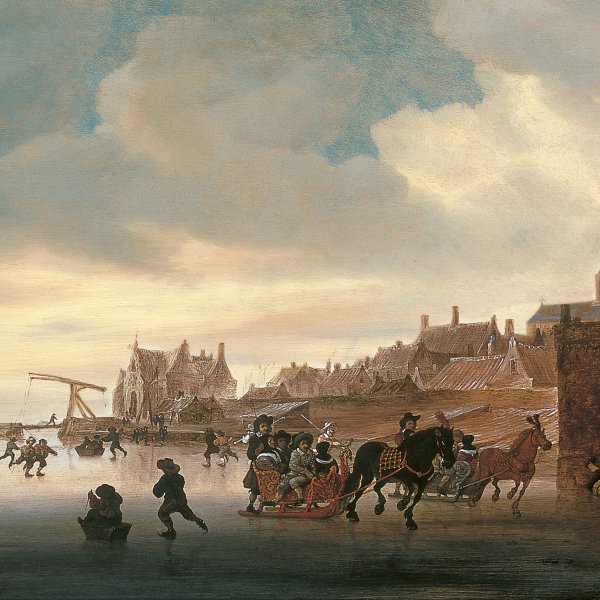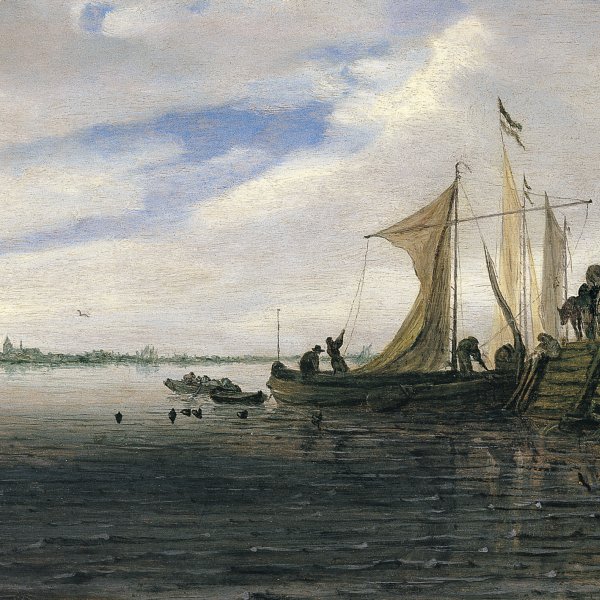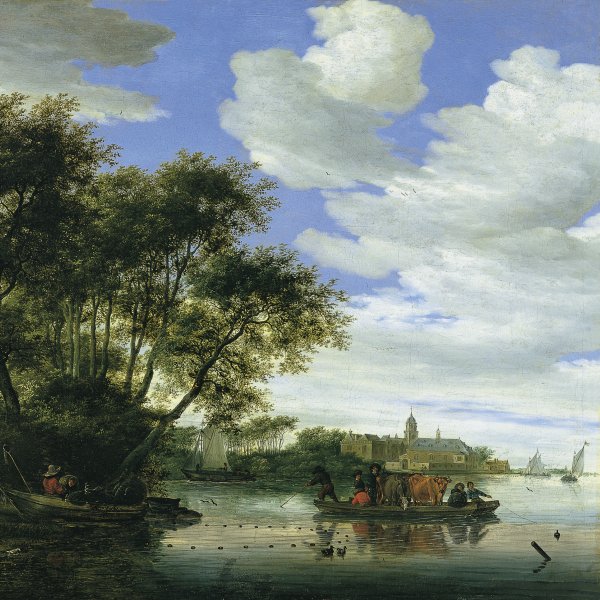Sailing Vessels moored near a Village
1660
Oil on panel.
46.1 x 63.5 cm
Museo Nacional Thyssen-Bornemisza, on deposit with Museo Nacional d'Art de Catalunya (MNAC)
Inv. no.
361
(1973.51
)
Not exhibited
Level 2
Permanent Collection
Level 1
Permanent Collection
Level 0
Carmen Thyssen Collection and Temporary exhibition rooms
Level -1
Temporary exhibition rooms, Conference room and EducaThyssen workshop
Sailing Vessels moored near a Village is a mature work by Salomon Jacobsz. van Ruysdael, painted in the last decade of his life. During this period Ruysdael continued to paint the subjects of his early output, which had enjoyed a warm reception, while he also tackled new motifs such as the still lifes of the late 1650s and early 1660s. In those vertical compositions he depicted dead game and farm animals arranged on simple surfaces or in rustic wicker baskets. He continued to use diagonal compositions in his landscapes but he also introduced new elements such as a brilliant, luminous palette with which he emphasised specific areas of his views. While his range of subjects was relatively limited and he frequently repeated them, every painting by this artist has an energy and sense of life that make them highly appealing.
The provenance of the present panel is known from the early 20th century onwards. In 1906 it was with the Paris dealer Charles Sedelmeyer, from there entering the Edouard Kann collection in Paris. It was later with the London dealer Thomas Agnew and with D. Heinemann in Berlin. Baron Heinrich Thyssen-Bornemisza acquired it from the Heinemann gallery and it appeared in the Collection’s catalogues until the Baron’s death in 1947. It was inherited by the Baron’s daughter Gabrielle and was in the Adolphe Bentinck collection. The painting was subsequently sold and passed through the hands of four more galleries until it was purchased by Baron Hans Heinrich Thyssen-Bornemisza from the Cramer gallery in The Hague. For this reason the panel appears in the Collection’s catalogues from 1930 to 1937 then disappears until 1986.
Ivan Gaskell considered the painting to be a good example of the transformation of Ruysdael’s work in the last decade of his career. Among the most striking features of his new style was the use of a range of bright, strong colours such as those seen here in the sky. This occupies an extensive area due to the low horizon line and features large cloud formations painted in tones of white, grey and orange. The diagonals used in his work of the 1630s here create an interplay of broken, waving lines used to construct the seashore where the boats are moored. The hulls of the boats form a diagonal that leads the eye towards the distant strip of land on the horizon. Ruysdael also introduced striking and subtle effects through the horizontal bands of light that construct the pictorial space, from the dark foreground to the more brightly lit background.
Gaskell changed the title of the painting, which had previously been Fishermen returning Home. He based his modification on a study of the boats, which appear to be merchant vessels used to transport cargo over long distances rather than fishing boats.
Mar Borobia
The provenance of the present panel is known from the early 20th century onwards. In 1906 it was with the Paris dealer Charles Sedelmeyer, from there entering the Edouard Kann collection in Paris. It was later with the London dealer Thomas Agnew and with D. Heinemann in Berlin. Baron Heinrich Thyssen-Bornemisza acquired it from the Heinemann gallery and it appeared in the Collection’s catalogues until the Baron’s death in 1947. It was inherited by the Baron’s daughter Gabrielle and was in the Adolphe Bentinck collection. The painting was subsequently sold and passed through the hands of four more galleries until it was purchased by Baron Hans Heinrich Thyssen-Bornemisza from the Cramer gallery in The Hague. For this reason the panel appears in the Collection’s catalogues from 1930 to 1937 then disappears until 1986.
Ivan Gaskell considered the painting to be a good example of the transformation of Ruysdael’s work in the last decade of his career. Among the most striking features of his new style was the use of a range of bright, strong colours such as those seen here in the sky. This occupies an extensive area due to the low horizon line and features large cloud formations painted in tones of white, grey and orange. The diagonals used in his work of the 1630s here create an interplay of broken, waving lines used to construct the seashore where the boats are moored. The hulls of the boats form a diagonal that leads the eye towards the distant strip of land on the horizon. Ruysdael also introduced striking and subtle effects through the horizontal bands of light that construct the pictorial space, from the dark foreground to the more brightly lit background.
Gaskell changed the title of the painting, which had previously been Fishermen returning Home. He based his modification on a study of the boats, which appear to be merchant vessels used to transport cargo over long distances rather than fishing boats.
Mar Borobia









